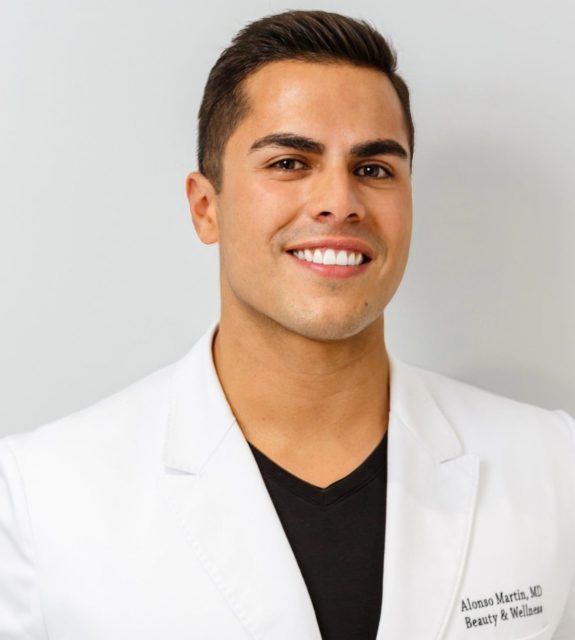Chances are you are familiar with Platelet-Rich Plasma (PRP) and its near miraculous faculties to revitalize the skin through the body’s own healing mechanisms. But what about PRP hair treatments?
Haute Beauty turned to its own contributor, Dr. Amelia K. Hausauer, who performs PRP hair procedures at Aesthetx, to understand more about the relatively new and minimally invasive treatments that promote hair growth.
Many think about skin procedures when they hear PRP. How did PRP-infused hair treatments come about?
PRP therapy is used in hair restoration as an alternative or complement to existing topical, oral and surgical treatments. It involves separating a portion of your own blood and injecting this solution back into the scalp. There are growth factors in a special type of blood cell called the platelet that awaken and help create a better environment for hair follicles so they may grow and thrive. PRP is a way to harness your body’s own ability to heal itself in a more natural and innovative technique.
Over the past decades, there has been an increasing effort to understand what biological cues control the hair growth cycle. We have long recognized that there are different phases of cyclical hair growth, including: telogen, the resting phase; anagen, the growth phase; catagen, the regression phase; and exogen, the shedding phase. But, the molecular signals triggering these transitions and how they may differ among individuals with male or female pattern hair loss have only become clear more recently.
It turns out PRP contains high concentrations of many of the same molecules and growth factors necessary in normal hair cycles and can stimulate critical genes that promote anagen hairs. The body only has so many ways that cells can communicate, so we take advantage of this redundancy and apply them to different parts of the body. Normally, the signals in PRP stop bleeding and help accelerate wound healing but if moved to another part of the body like the scalp, they can also stimulate hair growth. Pretty fantastic for a relatively noninvasive and natural procedure!
Walk us through the steps of a typical PRP hair treatment. Do patients need any preparation; is the procedure painful?
Part of the confusion and variability in results seen with PRP comes from the fact that platelet-rich plasma actually just refers to a solution that is separated from one's own blood with a greater concentration of platelets than red blood cells. Circulating whole blood is mainly comprised of red blood cells with many fewer platelets in a fixed volume. So basically, PRP is a reversal in what’s normal.
The exact ratio and composition, however, varies from clinic to clinic, preparation technique to preparation technique. Finding an experienced physician such as a board-certified dermatologist or plastic surgeon who knows a lot about the basic science of PRP can help demystify the process and ensure the best efficacy.
I ran a clinical trial using PRP for hair regrowth and am very comfortable explaining the procedure and expected results. At my practice, Aesthetx, I use a highly purified solution because there is scientific evidence to suggest it works better and is less painful. Our basic procedure involves the following:
- drawing blood just like when you have routine labs checks;
- spinning this blood in a centrifuge, a machine that rotates rapidly like a carousel to separate the different blood components by their weight;
- removing only the portion of the solution desired; and finally
- injecting small volumes of the fluid back into the scalp.
Steps 3 and 4 are the most variable. Some physicians add medications or other ingredients into their solutions to make the platelets start reacting. I do not, largely because adding other substances either increases the risk of side effects or discomfort for patients. And while the process sounds like “torture” to many, most patients are surprised by how easy and quick the treatment can be. As a matter of fact, when under my care, patients give an average pain score between two and four on a 0-10 pain scale without any numbing medication. If we use an anesthetic cream, it often drops even further.
There is also little preparation and minimal downtime, but I do advise patients to avoid heavy alcohol consumption before or after receiving PRP, not dye their hair within 24 hours of injections and limit blood thinners if possible. The scalp tingles and feels "active" for about 24 hours, so I let patients know that taking a warm shower may help alleviate that sensation.
Are there any hair types that are better candidates for PRP? How does the procedure affect disparate hair types?
The strongest literature supporting the use of PRP is among those with male or female pattern hair loss, termed Androgenetic Alopecia. This condition is the most common type of balding or thinning, the kind that often runs in families. PRP works best if started early, especially in the first 5 years of noticing balding or thinning, but can be beneficial for those with a longer history of disease as well. It is not as effective at thickening and re-growing hairs where they are entirely gone and imperceptible to the naked eye, such as someone with a fully bald head.
There is less robust literature on the treatment of Alopecia Areata, an inflammatory condition that often presents with shiny round patches of complete hair loss. Personally, I have had good success with a condition called Traction Alopecia, the type of hair loss that occurs due to long-standing tension and pulling on hairs from extensions, braids and other styling processes. As long as those follicles haven't scarred down (which takes years, even decades to occur), PRP can help nourish and bulk up the hairs. As a result, many of my patients no longer need wigs, weaves, and other artificial hair pieces.
In many cases, PRP is used to treat hair loss, but can it help with such issues like thin hair, or hair that has lost its luster and hydration?
This is a more complicated topic. We know that a hallmark of Androgenetic Alopecia is the shrinking of hairs, a process called miniaturization, and PRP can help widen those shafts. The effect on my patients personally is on average 30% over six months. This percentage often increases further during the first year with repeated treatment sessions. However, the jury is still out on whether PRP can change the hair with which you're born. Mechanistically, the growth factors in PRP increase the number of tiny blood vessels supplying nourishment to hair follicles and ensure better circulation and nutrient delivery. Therefore, it would theoretically make sense that PRP could better support even normal or heat-damaged hair. Anecdotally, my patients say yes, but we need much more rigorous clinical studies to make any conclusions or recommendations.
Many suffer from hair loss due to hormonal imbalances, can PRP help in such cases? How?
More than likely, PRP cannot help in such cases. Thyroid disease, post-pregnancy hair loss, estrogen depletion that can result from medication, etc. can all impact hair growth and quality. The best way to help your hair in these conditions is to correct the imbalance.
There is also a condition known as Telogen Effluvium which involves massive, simultaneous shedding of hair several months after the body goes through something highly stressful such as hormonal irregularity, a major illness, or surgery. Usually, these hairs return spontaneously over the course of about a year, and again, PRP has not accelerated the recovery period due to these conditions. I personally screen all of my patients for these conditions prior to starting therapy so we don't miss any contributing medical conditions and can decide on the most efficacious and individualized plan.
PRP can be used after hair transplantation to enhance the results of the procedure. How does it help and are there any particular considerations using PRP after a surgical procedure?
Hair transplantation plus PRP is a fabulous combination for several reasons. First, PRP makes the scalp a more hospitable and welcoming environment for the new hair grafts, thereby increasing the percent that thrive and grow. Second, it enhances the donor site (region from which hairs are taken) with wound healing and minimizes scarring. Third, it speeds up the healing process within the recipient site (region receiving the new hairs). Lastly, PRP can be used as an ongoing maintenance therapy after transplantation to maintain the new growth and the surrounding non-transplanted hairs over time.
How many PRP treatments are needed for the results to start showing?
I always stress that male and female pattern hair loss is a chronic, longstanding condition. Even hair transplantation isn't a cure-all, since adjacent areas or pre-existing, untransplanted hairs may eventually thin as well. Those hormonal and molecular signals that triggered hairs to miniaturize in the first place still exist.
Hence, PRP is an ongoing treatment. We often start with monthly sessions while actively trying to ramp up growth, but then gradually spread sessions out as appropriate. It takes at least three to six months before changes are at all noticeable, because hair grows at such a slow rate. Some patients don't notice major changes until nine to 12 months and then – aha!
I like to take magnified photographs to monitor more scientifically and precisely the number of new hairs and the average increase in thickness of the hair shafts since I’m able to pick up changes on these images before they are easily seen with the naked eye. This information also gives the patient more immediate relief and satisfaction knowing that the procedure is working for them.
Bottom line, in my mind, any product or procedure that promises a quick fix is likely false advertising and not a scientifically sound solution.



























